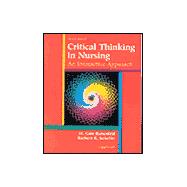
| Part I Overview of Thinking, Doing, and the Nursing Process | 1 | (126) | |||
|
3 | (26) | |||
|
4 | (16) | |||
|
20 | (2) | |||
|
22 | (3) | |||
|
25 | (4) | |||
|
29 | (18) | |||
|
29 | (6) | |||
|
35 | (11) | |||
|
46 | (1) | |||
|
47 | (22) | |||
|
47 | (4) | |||
|
51 | (3) | |||
|
54 | (4) | |||
|
58 | (1) | |||
|
59 | (5) | |||
|
64 | (3) | |||
|
67 | (2) | |||
|
69 | (22) | |||
|
69 | (4) | |||
|
73 | (7) | |||
|
80 | (10) | |||
|
90 | (1) | |||
|
91 | (18) | |||
|
91 | (1) | |||
|
92 | (1) | |||
|
92 | (2) | |||
|
94 | (10) | |||
|
104 | (3) | |||
|
107 | (2) | |||
|
109 | (18) | |||
|
109 | (3) | |||
|
112 | (11) | |||
|
123 | (1) | |||
|
124 | (1) | |||
|
125 | (2) | |||
| Part II Details of Thinking and the Nursing Process | 127 | (102) | |||
|
129 | (20) | |||
|
129 | (1) | |||
|
130 | (17) | |||
|
147 | (2) | |||
|
149 | (26) | |||
|
152 | (2) | |||
|
154 | (5) | |||
|
159 | (2) | |||
|
161 | (5) | |||
|
166 | (5) | |||
|
171 | (1) | |||
|
172 | (2) | |||
|
174 | (1) | |||
|
175 | (30) | |||
|
175 | (2) | |||
|
177 | (3) | |||
|
180 | (2) | |||
|
182 | (7) | |||
|
189 | (14) | |||
|
203 | (2) | |||
|
205 | (24) | |||
|
206 | (3) | |||
|
209 | (6) | |||
|
215 | (3) | |||
|
218 | (1) | |||
|
218 | (1) | |||
|
219 | (6) | |||
|
225 | (3) | |||
|
228 | (1) | |||
| Part III Communicating Thinking and the Nursing Process | 229 | (56) | |||
|
231 | (30) | |||
|
232 | (1) | |||
|
232 | (1) | |||
|
233 | (7) | |||
|
240 | (13) | |||
|
253 | (6) | |||
|
259 | (2) | |||
|
261 | (24) | |||
|
262 | (5) | |||
|
267 | (8) | |||
|
275 | (4) | |||
|
279 | (2) | |||
|
281 | (1) | |||
|
281 | (1) | |||
|
282 | (3) | |||
| Part IV Thinking Through a Complex Patient Situation | 285 | (96) | |||
|
287 | (26) | |||
|
294 | (1) | |||
|
294 | (1) | |||
|
295 | (1) | |||
|
295 | (4) | |||
|
299 | (6) | |||
|
305 | (4) | |||
|
309 | (2) | |||
|
311 | (2) | |||
|
313 | (18) | |||
|
314 | (3) | |||
|
317 | (4) | |||
|
321 | (7) | |||
|
328 | (1) | |||
|
329 | (2) | |||
|
331 | (18) | |||
|
332 | (4) | |||
|
336 | (1) | |||
|
337 | (8) | |||
|
345 | (1) | |||
|
346 | (3) | |||
|
349 | (16) | |||
|
350 | (2) | |||
|
352 | (4) | |||
|
356 | (5) | |||
|
361 | (1) | |||
|
362 | (3) | |||
|
365 | (16) | |||
|
365 | (1) | |||
|
366 | (5) | |||
|
371 | (2) | |||
|
373 | (4) | |||
|
377 | (4) | |||
| Appendix A Nursing Diagnoses, North American Nursing Diagnosis Association, 1999-2000 | 381 | (4) | |||
| Appendix B Nursing Interventions Classification (NIC) Taxonomy | 385 | (14) | |||
| Appendix C Nursing Outcomes Classification (NOC) Outcomes and Measurement Scales | 399 | (11) | |||
| Appendix D Tracking Nursing Thinking (TNTa) Checklist: Guidelines for Use | 410 | (4) | |||
| Appendix E Tracking Nursing Thinking (TNTb) Guidelines and Checklist (Streamlined for Assessment and Planning Only) | 414 | (2) | |||
| Appendix F Thinking Worksheet for Tracking Nursing Thinking (TNTb) Checklist | 416 | (1) | |||
| Appendix G Care Planning in the Form of a Mind Map | 417 | (2) | |||
| Bibliography | 419 | (6) | |||
| Index | 425 |
The New copy of this book will include any supplemental materials advertised. Please check the title of the book to determine if it should include any access cards, study guides, lab manuals, CDs, etc.
The Used, Rental and eBook copies of this book are not guaranteed to include any supplemental materials. Typically, only the book itself is included. This is true even if the title states it includes any access cards, study guides, lab manuals, CDs, etc.